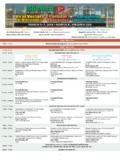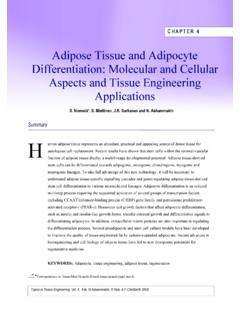Transcription of NEUROPROTECTION IN GLAUCOMA: ROLE OF BRIMONIDINE
1 NEUROPROTECTION IN GLAUCOMA: ROLE OF BRIMONIDINE . New Explanations for Glaucomatous Damage Glaucoma is the second leading cause of blindness worldwide. million people world wide suffer from Four new discoveries have allowed clinicians to better glaucoma and that million people have bilateral understand glaucomatous damage. blindness secondary to glaucoma vision less than 1. Glaucomatous loss shares certain similarities with 20/400 or 3/60 in the better eye. The blindness caused classic apoptosis. by glaucoma is irreversible. 2. Elevated nitric oxide levels may contribute to Classic Theories of Glaucomatous Damage ganglion cell loss. In the normal eye, the retina is a layered array of 3. Elevated glutamate levels may contribute to cells that absorbs light and converts it to an electrical ganglion cell loss signal. All visual processing in the eye culminates at the innermost retinal layer containing the ganglion 4. There may be an autoimmune component to cells. Axons from these neurons form the optic nerve glaucomatous optic neuropathy.
2 And exit the eye at the lamina cribrosa to form their These findings allow physicians to begin to propose a first synapse at the lateral geniculate. Glaucoma damages these axons; this loss is seen clinically as new approach to the management of this disease . increased cupping or excavation of the optic nerve. If the concept of NEUROPROTECTION . Although preservation of the optic nerve is the goal of all severe enough, glaucoma can lead to visual field compromise and eventual blindness. pressure-lowering therapies, the term NEUROPROTECTION in the context of glaucoma has come to mean The glaucomas generally involve impaired aqueous intervention directed at preserving vision by saving outflow from the anterior chamber of the eye and a retinal ganglion cells without necessarily lowering the consequently elevated IOP. For all forms of glaucoma, IOP. the majority of both medical and surgical therapies NEUROPROTECTION is based on the principle of: are directed at lowering the IOP.
3 1. Reduce risk factors: lower the IOP, reduce Unf ortunately, this is not enough. Even though the IOP. ischemia can be brought into the normal range, visual field loss 2. Promote neuronal survival and blindness can still develop in 25% to 38% of patients. These observations suggest that factors 3. And/or inhibit cell death other than control of the IOP should be considered if glaucomatous blindness is to be prevented. One Excess glutamate can be toxic to normal RGC's through recent study suggests that 27% of patients would go over stimulation of N-Methyl-D-Aspartae (NMDA). blind in at least 1 eye after 20 years with glaucoma. receptors. The NMDA receptor is a major type of Although control of IOP is likely to remain the mainstay glutamate receptor that when over activated can kill of glaucoma therap y, investigation of contributory retinal ganglion cell. factors beyond IOP may be helpful if glaucomatous The Bcl-2 family of gene proteins performs a central blindness is to be prevented.
4 Role in regulating apoptosis. Members of Bcl-2 gene Two distinct theories were proposed in 1858 to explain family that promote programmed cell death include glaucomatous optic nerve damage. Muller suggested bad and bax; in contrast, the expression of bcl-2 and that neuronal loss was due to mechanical trauma and bcl-xl suppresses the apoptic programme. To date, that the increased pressure in glaucoma directly alpha-2 pathways have been identified that increase compromised the nerve; von Jaeger proposed that expression of bFGF, induce bcl-2 and bcl-xl genes, and vascular compromise was a fault. Almost 150 years enhance the availability of important neurotrophic later, both theories still have strong proponents, and factors. this debate remains unresolved. BRIMONIDINE Tartrate: Role in NEUROPROTECTION In the late 1960s and early 1970s, the theory was BRIMONIDINE is a2-selective agonist. It is an analogue proposed that elevated IOP would block axoplasmic of clonidine. It is about thirty fold more a2 selective flow at the lamina cribrosa.
5 This might prevent trophic and has very low affinity for a1 receptors. Due to this factors from reaching the ganglion cell body and cause reason, mydriasis and lid lag as found with non- the cells to initiate a suicide response resulting in selective agonists like clonidine are eliminated. programmed cell death (apoptosis). Its main mechanism of action is suppression of aqueous formation, but it is also claimed to increase some degree of uveoscleral outflow. 26 Journal of the Bombay Ophthalmologists' Association Vol. 13 No. 1. Administration of BRIMONIDINE 14 hours before injury The most significant merit of BRIMONIDINE also resulted in RGC survival that was similar to that (Brimodin) is its relative systemic safety profile when administered immediately after injury. and its postulated function of NEUROPROTECTION through upregulation of cellular and neuronal Thus BRIMONIDINE protected the rat optic nerve from survival factors, such as bFGF1 in response to secondary damage following mechanical injury to the activation of the a2 adrenergic receptors, and optic nerve and was nontoxic in an array of experiments increase in ocular blood flow.
6 Designed to evaluate ocular and organ to xicity. Animal Study proving BRIMONIDINE as a neuroprotective Taken together, the high a2 -adrenoceptor agent selectivity, ocular hypotensive efficacy, retinal bioavailability and neuroprotective properties Role of a2-adrenergic receptors in NEUROPROTECTION and make BRIMONIDINE an important addition to the glaucoma field of anti-glaucoma agent. Ref: Survey of Ophthalmol; V. 45; Suppl 3; May 2001: Further reading: S290-S294. 1. Surv Ophthalmol 41 (Suppl): S9-S18 Rats were anesthetized and the optic nerve was injured. BRIMONIDINE at mg/kg was given by 2. Drugs and Aging 1998 12 (3): 225-241. intraperitoneal injection at 14 hours before optic nerve 3. JAMA 1999 281(4): 306-308 injury or immediately after injury (time 0). Control animals received phosphate buffered saline (PBS). 4. of Ophthal 1996; 80: 389-93 vehicle. Ganglion cell survival was evaluated 12 days later. Neuropr otective effect was the difference 5. Lancet 1999; 364: 1803-10.
7 Between the control and BRIMONIDINE group. The article is written by Sandhya Sawant, Medical Services, Cipla Ltd. Results BRIMONIDINE at mg/kg when injected intr aperitoneally, immediately after injury (time 0). resulted in ganglion cell survival of about two-fold.






